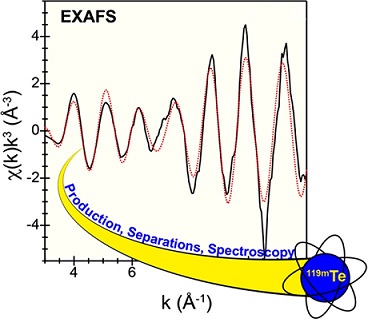Radioisotope-based medical therapies rely upon the emission of radioactive particles to deliver a destructive radiation dose to diseased tissue while leaving adjacent healthy tissue unscathed. Auger-emitting isotopes could serve as excellent radiotherapeutic agents because their short path length in biological tissue (~10 µm) allows for precise targeting of cancer cells. This means that these therapies have many fewer side effects than traditional chemotherapies. One promising Auger-emitting isotope for medical therapies is 119Sb, however its use has been limited because its short half-life (~38 hours) makes access to it difficult at medical facilities. In this work, the researchers have developed a protocol for producing longer-lived 119Te from an irradiated Sb metal target. 119Te degrades to 119Sb, so it can be shipped to medical facilities where it will produce the required 119Sb for up to ~45 days.
To produce 119Te, an Sb metal target was placed in the path of a high energy proton beam (42.5 MeV) at the Los Alamos Neutron Science Center (LANSCE). This generated a very small quantity (~1016 atoms) of highly radioactive 119Te, which then had to be separated chemically from 25 grams of Sb. This work is done in Hot Cells so that the high levels of radioactivity (2.7 Ci) can be handled remotely.
One of the key challenges to obtaining 119Te was to isolate it from the irradiated Sb target. A high level of purity is required in order to receive FDA approval, which is necessary for drug development. Radioisotope separations typically rely on the use of commercially available resins that preferentially bind the radioisotope of interest. Ideally, all other components of the mixture exhibit little or no reactivity towards the resin. In this case, the irradiated Sb metal target was dissolved in concentrated acid and then passed through a series of resins. However, our initial efforts were unsuccessful. The team therefore turned to x-ray absorption spectroscopy (Beam Line 11-2) to develop a protocol that took advantage of the different chemical properties of Te and Sb.
Extended x-ray absorption fine structure (EXAFS) and x-ray absorption near edge structure (XANES) spectroscopy were used to examine the speciation (oxidation state and coordination environment) of Sb and Te in the acid solutions used to load the resins. The spectroscopic analysis revealed that Te existed as a positively charged species at low acid concentrations and as a neutral species at high acid concentrations; whereas Sb transitioned from being neutral to carrying a negative charge as the acid concentration increased. This insight provided a method for separating Te and Sb based on the concentration of the acid used to load the resin.

X-ray absorption spectroscopy (XAS) has been used to understand solution speciation to develop improved separation of the 119mTe parent from the 119Sb daughter. ACS Cent. Sci., DOI: 10.1021/acscentsci.8b00869
EXAFS and XANES spectroscopies were also used to examine the speciation of Te sorbed by the separation resins. The first resin in the sequence (“CL” resin) separated out 99.994 % of the Sb from the 119Te. Te K-edge EXAFS spectroscopy revealed that the reason for the remarkable efficiency of this step was the unexpected reduction of Te(IV) to Te(0), which entirely removed Te from solution. Sb, in contrast, remained in the +V oxidation state and was eluted in concentrated hydrofluoric acid. This result was entirely unexpected based on the reported reactivity of the resin; without EXAFS spectroscopy, the origin of this behavior would have been inscrutable.
Te(0) was removed from the first column using concentrated nitric acid, which oxidized it back into the +IV oxidation state. To purify this solution further, it was loaded onto a second resin- the “Rare Earth” resin, which was intended to covalently bind Te(IV). EXAFS spectroscopy, however, revealed that Te(IV) acquired a negative charge at the resin-solution interface. Under the acidic conditions present, the resin functional group became protonated, acquiring a positive charge that attracted the negatively charged Te species. Some Sb (also negatively charged) stuck to the Rare Earth resin, necessitating one final separation step.
Lastly, an anion exchange resin was used to remove Sb to acceptable levels. The anion exchange resin was loaded with relatively dilute hydrochloric acid. Under these conditions, Sb was neutrally charged and passed through the resin unhindered. Te, in contrast, was revealed to be a negatively charged species, and remained fixed to the resin.
In summary, x-ray absorption spectroscopy provided key insight into the speciation of Te and Sb during the separation process, which ultimately allowed for the development of a rapid (36 hour) procedure to purify 119Te to a level that is consistent with the needs of drug manufacturers. This work therefore represents as important step in the development of Auger-emitting radiotherapies.
K. T. Bennett, S. E. Bone, A. C. Akin, E. R. Birnbaum, A. V. Blake, M. Brugh, S. R. Daly, J. W. Engle, M. E. Fassbender, M. G. Ferrier, S. A. Kozimor, L. M. Lilley, C. A. Martinez, V. Mocko, F. M. Nortier, B. W. Stein, S. L. Thiemann and C. Vermeulen, "Large-scale Production of 119mTe and 119Sb for Radiopharmaceutical Applications", ACS Cent. Sci. 5, 494 (2019) doi: 10.1021/acscentsci.8b00869
LA-UR-19-23603




